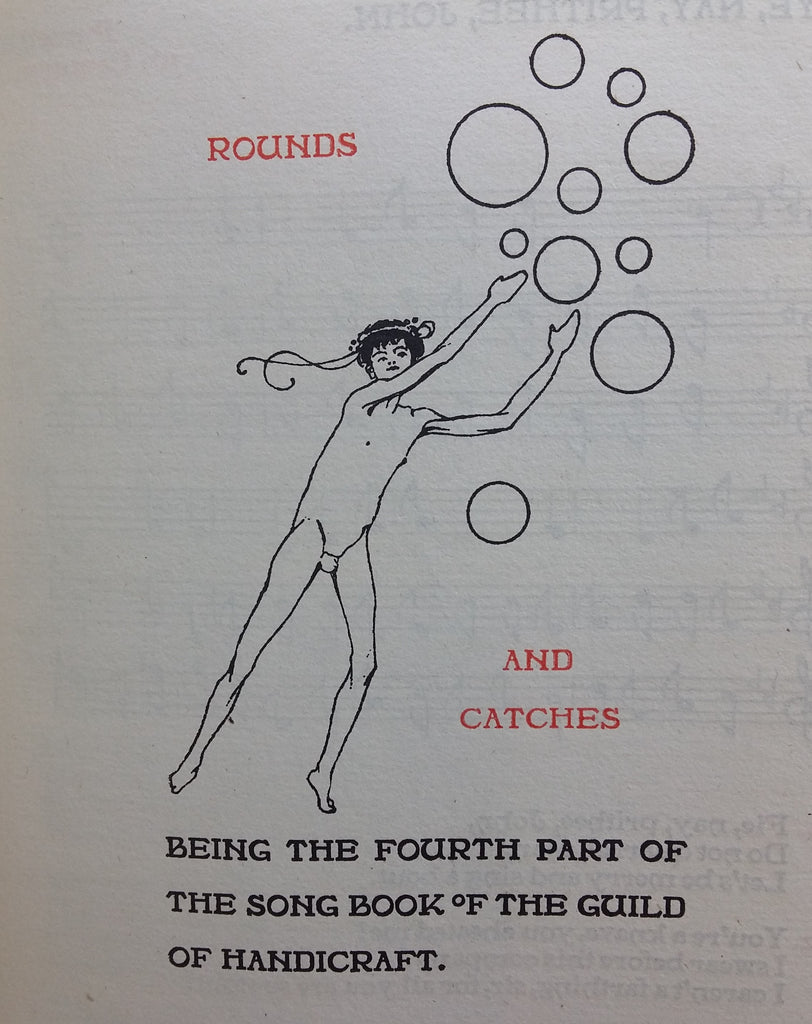
Among the joys and privileges of being based at Voewood is working against the backdrop of one of the finest Arts and Crafts houses. There is a short introduction to the house elsewhere on the website but I started to think a little more about the construction of the house when looking at a lovely Arts and Craft book we have recently bought. It is The Essex House Song Book printed at the Essex House Press by C.R Ashbee and his wife Janet.

Charles Ashbee was one of the great designers of the Arts and Craft Movement. His father was Henry Spencer Ashbee, the bibliophile and bibliographer, whose interests lay in rather different directions. Charles was an architect and interior designer: one of his most celebrated buildings is the Villa San Giorgio in Taormina, Sicily which is now a, not very arts and craft, luxury hotel. He designed jewellery and furniture and in 1888 founded the Guild of Handicraft which brought together the social (and socialist) ethics and the design aesthetics of the Arts and Craft Movement. The Guild of Handicraft was described, in its own rules, as “a body of men of different trades, crafts and occupations, united together on such a basis as shall better promote the goodness of the work produced and the standard of the life of the producer. To this end it seeks to apply to the collective work of its members whatever is wisest and best in the principles of Co-operation...”

The Guild began in the East End of London and in 1902 established itself in the Cotswolds at Chipping Campden. Under the auspices of the Guild of Handicraft, Charles and Janet Ashbee founded the Essex House Press in 1898 as a successor to the Kelmscott Press: indeed, many of the craftsmen from Kelmscott joined Essex House and Ashbee bought some of William Morris’s printing machinery. Its first book was Benvenuto Cellini’s Treatise on Metalwork and Sculpture and it went on to print between eighty and ninety works (mainly architecture, design and poetry) until it was brought to an end by Ashbee in 1909.
The Essex House Press has been described as coming “from the heart of the arts and craft movement” and there is something echt about its aims and achievements particularly when seen in the wider context of the Guild of Handicrafts. One of the Guild traditions was the evening gathering of members to sing and make music. The songs they sang were collected and printed and they became The Essex House Song Book. Ashbee’s view was that this book expressed the idea of the Guild most fully: “To me, perhaps, [the Guild’s Idea’s] completed expression in the life of the Guild is to be found in its Song Book, printed and published by the Essex House Press in 1905, and entirely ignored by the General Public”.
The Song Book is divided into ten parts, each part representing a different theme so there are titles such as Songs of Praise, Songs of Loyalty and the Love of the Land, Songs of the Country and the tilling of the Soil, Songs of the Tavern and the Vine and Songs of Comradeship, Love & Courtship. The collection is a wonderfully eclectic one, encompassing hymns, English county folksongs, hunting songs attributed to Henry VIII, songs written by Ashbee himself, Rule Britannia and the National Anthem.
These songs were printed in a limited edition of two hundred on (handmade) paper and five on vellum between 1903 and 1905 and initially gathered loose in green buckram portfolios. Most copies are now bound. It was printed in Ashbee’s own Endeavour typeface (he designed another, King’s Prayer Book), which is seen as “livelier than other private press types, thanks to its more eccentric letters”. Endeavour is lively and eccentric but it does have the honest beauty of all true arts and crafts designs.
Reading about The Essex House Song Book, I was struck by the dates as these coincide with the construction of Voewood. E.S Prior, the architect of Voewood, knew Ashbee (in fact, the leading figures of the Arts and Crafts Movement all knew each other) and we know that Ashbee had attended a lecture given by Prior in Edinburgh in 1889 to the National Association for the Advancement of Art and its Application to Industry of which they were both members.
Prior and Ashbee would almost certainly have talked about the condition of their workers and craftsmen. Prior, though his clerk of works at Voewood, Randell Wells, kept a close control of all aspects of the design and building of the house and garden. Not only did Prior, in the arts and craft manner, use local materials, he also employed local workers (we know that his chief bricklayer was a Norfolk man, Mr Blower). A project the size of Voewood would have been a community affair (“a body of men of different trades, crafts and occupations”) and would have aimed at Ashbee’s ideal of the “wisest and best in the principles of Co-operation...”


Whether Prior’s workforce at Voewood got together in the evenings to sing songs we do not know. There was no formal Guild to match Ashbee’s but North Norfolk would have been a very small world then, social life and entertainment somewhat limited (no jokes please) so we can, I think, easily imagine Prior’s men, after a day working on this bizarre, radical and innovative house, gathering to sing sea shanties, songs about village craftsmen, fishing and hunting, all rounded off with some rousing Norfolk Folksongs. It is a romantic and beguiling thought.
Andrew Taylor. xii. v. xvii

Leave a comment